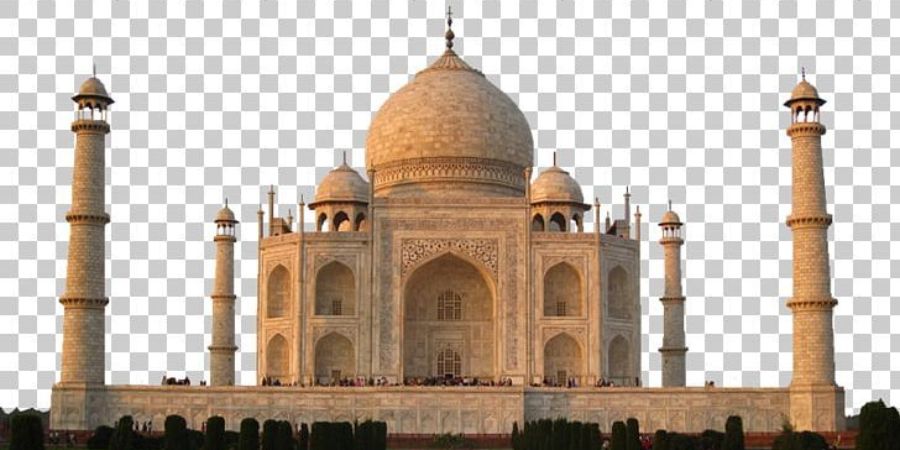

The Taj Mahal literally “crown of the palace” is an ivory marble mausoleum on the right bank of the Yamuna River in Agra, Uttar Pradesh. India. In 1631 the fifth Mughal emperor Shah was commissioned by his Jahan (r. 1628–1658) to house the tomb of his mahal, his favorite wife Mumtaz. There is also the tomb of the Shah Jahan himself, which is the centerpiece of his 17-hectare complex that includes a mosque and guest house, set in formal gardens bordered on three sides by crenellated walls. Construction of the mausoleum was basically completed in 1643, but work on the other phases of the project continued for another decade. The Taj Mahal complex is believed to have been fully completed in 1653, with an estimated cost of around £32 million at the time, equivalent to around £70 billion (approximately US$1 billion) in 2020 . The construction project employed some 20,000 craftsmen under the direction of an architects commission led by Ustad Ahmad Rahuri, the Emperor's court architect. Various types of symbols have been used in the Taj to reflect the beauty and divinity of nature.
The Taj Mahal was declared a World Heritage Site by UNESCO in 1983 as "a jewel of Islamic art in India and one of his world heritage masterpieces admired around the world". It is considered by many to be the finest example of Mughal architecture and a symbol of India's rich history. The Taj Mahal attracts more than six million tourists each year[3] and was declared the winner of the New Seven Wonders of the World (2000-2007) in 2007.
The Taj Mahal integrates and extends the design traditions of Indo-Islamic architecture and early Mughal architecture. Particular inspiration came from successful Timurid and Mughal buildings, including the Gur-e Amir (the tomb of Timur, ancestor of the Mughal dynasty in Samarkand), the Humayun Tomb, the Charbagh Gardens, and the Hasht Behesht Plan (architecture). rice field. site, the Tomb of Itmad-Ud-Daulah (sometimes called Baby Taj), and Shah Jahan's own Jamahi Masjid in Delhi. Early Mughal buildings were built primarily of red sandstone, but Shah Jahan encouraged the use of white marble inlaid with semi-precious stones. The buildings under his patronage reached a new level of sophistication.
The most spectacular feature is the marble dome over the tomb. The dome is nearly 35 meters (115 feet) high, roughly the same length as the base, and is accented by a cylindrical "drum" about 7 meters (23 feet) high. Because of its shape, the dome is often called the onion dome or amrud (guava dome). The top has a lotus design to emphasize its height. The shape of the dome is emphasized by his four small domed chatrices (kiosks) placed at its corners, replicating the onion shape of the main dome. The dome is slightly asymmetrical. The base of those columns opens through the roof of the tomb, providing light to the interior. A tall decorative tower (gurdasta) extends from the edge of the base wall to visually emphasize the height of the dome. The lotus motif is repeated in both chhatris and guldasthas. The dome and chatris are adorned with golden finials that combine traditional Persian and Hindu decorative elements.
The main knob was originally gold, but was replaced by a gold-plated bronze copy in the early 19th century. This feature is a clear example of the synthesis of traditional Persian and Hindu decorative elements.The upper part is crowned with a typical Islamic motif, the moon, with its horns reaching towards the sky. There is The minarets, each over 40 meters high, testify to the designer's obsession with symmetry. They were designed as functioning minarets. This is a traditional feature of mosques used by Muezin to call Muslims to prayer. Each minaret is effectively divided into three equal parts by two working balconies surrounding the tower. At the top of the pagoda is the final balcony above which is a chatri that reflects the design of the tomb. The chatrices all share the same decorative element of a lotus design topped with a gold-plated finial. Because the minaret was built slightly outside the base, the tower material tended to fall out of the tomb in the event of a collapse, typical of many high-rise buildings of the time.
The exterior decoration of the Taj Mahal is one of the finest examples of Mughal architecture. As the surface changes, the decoration is proportionately refined. Decorative elements were created by applying paint, stucco, stone inlays or engravings. According to Islam's prohibition on the use of anthropomorphic forms, decorative elements can be classified as either calligraphic, abstract shapes, or botanical motifs. Throughout the complex there are Quranic verses that form part of the decorative elements. Recent studies suggest that Amanat Khan chose the passage .
The calligraphy on the Daimon reads, "Soul, thou rest at rest. The calligraphy was created in 1609 by a calligrapher named Abdul Haq. gave him the title "Amanat Khan". Near the lines of the Qur'an at the base of the inner dome is the inscription, 'Written by an insignificant being, Amanat Khan Siraj.29] It is inlaid in a white marble slab. Higher fields are written in a slightly larger font to reduce the sloping effect when viewed from below. The calligraphy found on the tomb's marble cenotaph is particularly detailed and delicate. [citation needed]
Abstract shapes are used sparingly, especially on the surfaces of pedestals, minarets, gates, mosques, jaws, and tombs. The domes and vaults of the sandstone building are decorated with tracery of carved paintings to create elaborate geometric shapes. A herringbone inlay defines the space between many of the adjacent elements. White inlays are used in sandstone buildings, while dark or black inlays are used in white marble. The mortared parts of the marble buildings are stained or painted in contrasting colors, creating an array of intricate geometric designs. Floors and walkways use contrasting tiles or blocks in a mosaic pattern.
The lower wall of the tomb has a white marble dado with realistic bas-reliefs of flowers and vines. The marble has been polished to bring out the fine details of the carvings. Dad frames and vaulted spandrels were decorated with pietradura he inlays of highly stylized, almost geometric tendrils, flowers and fruits. The inlaid stones are made of yellow marble, jasper and jade, polished and flattened to match the wall surface .
The interior chambers of the Taj Mahal go far beyond traditional decorative elements. The inlay is not pietra dura, but lapidary work with precious and semi-precious stones . The back room is octagonal and can be entered from either the left or right, but only the door to the south garden is used. The inner walls are about 25 meters high and topped by a 'fake' inner dome with a sun motif. Eight pishtak arches define the floor-level space, and like the exterior, each pishtak at the bottom is covered by his second pishtak, roughly in the middle of the wall. His four arches in the upper central part form balconies or viewing his areas, and the outer windows of each balcony have intricate screens or jalis carved out of marble. In addition to the light from the balcony screen, light enters through a chatrice-covered roof opening in the corner. The octagonal marble screen (jali) adjacent to the cenotaph consists of eight marble slabs with intricate perforations. The rest of the surface is decorated with intricate details of semi-precious stones that form intertwined tendrils, fruits and flowers. The walls of each room are highly decorated with Dado bas-reliefs, intricate gemstone inlays, and intricate calligraphic panels, detailing the design elements found throughout the intricate exterior.
Islamic tradition forbids elaborate tomb decorations. Therefore, the bodies of Mumtaz and Shah Jahan were placed in relatively plain crypts under the inner chambers, with their faces facing right towards Mecca. The Mumtaz Mahal cenotaph sits right in the center of the inner chamber on a 1.5 x 2.5 meter (4 ft 11 in x 8 ft 2 in) rectangular marble base. Both the base and the box are intricately set with precious and semi-precious stones. A calligraphic inscription on the coffin identifies and praises Mumtaz. The box lid has a raised rectangular lozenge that is believed to mark the dial. The Shah Jahan Cenotaph, next to Mumtaz on the west side, is the only visible asymmetrical element in the entire complex. His cenotaph is larger than his wife's but reflects the same elements:
A large coffin on a slightly elevated base, precisely decorated with its identifying gemstones and calligraphy. The lid of the box has the traditional carving of a small pen box .
The pencil case and writing board are traditional Mughal funerary icons, adorning the male and female coffins respectively. The sides of the actual tomb of Mumtaz Mahal are inscribed with the 99 names of the gods in calligraphy. Other inscriptions in the crypt include "O Noble, O Grandios, O Majestic, O Unique, O Eternal, O Glorious...". Shah Jahan's tomb bears the following calligraphic inscription: “He departed from this world to the eternal banquet hall on the night of the 26th day of the month of Rajab in the year 1076 of the Hijra calendar.”


